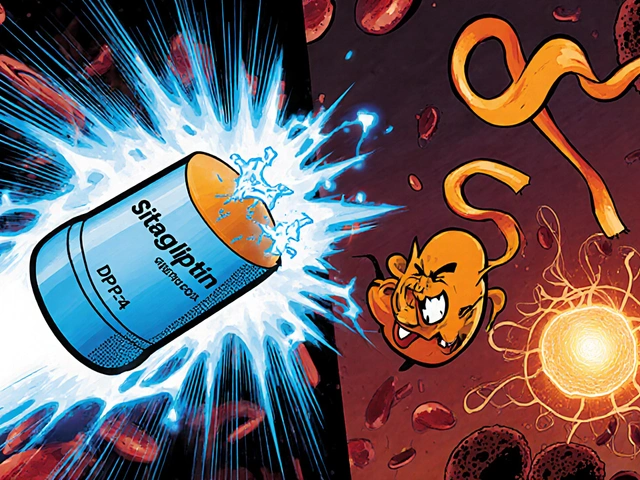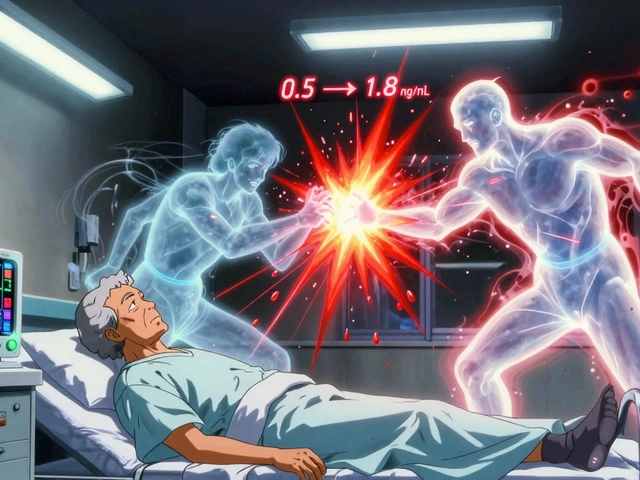Cough Therapy Comparison Tool
Compare Cough Treatments by Key Criteria
Mechanism
Block sensory nerve receptors involved in triggering cough
Regulatory Stage
Phase III (U.S.)
Administration
Oral tablet
Mechanism
Deliver broad-spectrum antivirals to airway epithelium
Regulatory Stage
Phase II (EU)
Administration
Dry-powder inhaler
Mechanism
Stimulate immunity against viral triggers
Regulatory Stage
Phase II completed
Administration
Intramuscular injection
Mechanism
Sound classification and risk scoring
Regulatory Stage
Commercially available (FDA cleared)
Administration
Smartphone app + wearable mic
Mechanism
Electrical stimulation of vagus nerve
Regulatory Stage
Pilot clinical trials
Administration
Hand-held stimulator
When it comes to easing a stubborn cough, cough treatments are therapies and medicines designed to suppress or relieve coughing have long been a staple of primary care. Yet the cough you hear in a winter clinic today is not the same cough that will be tackled in 2030. New pathogens, antibiotic resistance, and a growing appetite for personalized care are reshaping the landscape. In this article we’ll walk through the biggest shifts on the horizon, from next‑gen drugs to AI‑driven monitoring, so you know what’s coming down the pipeline.
Why cough remains a tough nut to crack
Cough is the body’s fastest reflex, a protective burst that clears airways. Because it serves so many purposes, completely shutting it down can be risky. That’s why clinicians have to balance symptom relief with preserving the cough’s defensive role. Studies from 2023‑2024 show that chronic cough affects roughly 10% of adults worldwide, costing health systems billions in visits and diagnostics. The condition is also a red flag for diseases ranging from asthma to early‑stage lung cancer, which makes accurate treatment even more critical.
What’s on the shelves today?
Traditional antitussive drugs medications that suppress the cough reflex, often by acting on the brain’s cough center like dextromethorphan and codeine dominate over‑the‑counter shelves. They work well for short‑term, non‑productive coughs but offer little for viral‑driven or chronic cases. Expectorants such as guaifenesin thin mucus, while bronchodilators address underlying airway constriction. The downside? Side‑effects, limited efficacy in viral infections, and growing concern over opioid‑based suppressants.
Novel drug classes on the rise
Researchers are targeting the cough pathway at more precise points. One promising class is the P2X3 antagonists molecules that block sensory nerve receptors involved in triggering cough. Early‑phase trials in 2024 reported up to a 60% reduction in cough frequency for patients with refractory chronic cough, with minimal central nervous system effects. Another avenue is antiviral inhalers dry‑powder formulations that deliver broad‑spectrum antivirals directly to the airway epithelium. By hitting the virus at the source, these inhalers aim to curb both infection and the inflammatory cough that follows.
Cough vaccine - could prevention replace treatment?
Vaccination against the cough itself may sound futuristic, but the concept is gaining traction. Researchers at the University of Melbourne are developing a cough vaccine an immunogenic formulation that primes the immune system to neutralize common viral triggers of cough, such as rhinoviruses and certain coronaviruses. PhaseII data released in July2025 showed a 45% reduction in medically attended cough episodes among high‑risk adults during flu season. If larger PhaseIII trials confirm safety and efficacy, the vaccine could become a seasonal adjunct for the elderly and those with chronic lung disease.
Digital health and AI-powered monitoring
Beyond pills, the future of cough care is increasingly digital. Wearable microphones paired with AI‑driven cough analysis machine‑learning algorithms that classify cough sounds by cause, severity, and duration can alert patients to seek care before a condition worsens. Companies like RespiroTech have rolled out a smartphone app that tracks cough frequency in real time and feeds the data into a cloud‑based clinician dashboard. Early adopters report a 30% drop in unnecessary doctor visits because the system helps differentiate a benign post‑viral cough from a sign of pneumonia.
Phytotherapy and the resurgence of herbal remedies
While high‑tech solutions dominate headlines, phytotherapy the use of plant‑derived extracts to treat cough and related respiratory symptoms is seeing a scientific renaissance. A 2024 meta‑analysis of 18 randomized trials found that standardized extracts of ivy leaf and pelargonium sidoides reduced cough severity by an average of 2.1 points on a 10‑point scale, with few adverse events. Researchers are now isolating active compounds to create semi‑synthetic derivatives that retain efficacy while ensuring batch‑to‑batch consistency.
Neuromodulation - a non‑pharmacologic frontier
Another cutting‑edge approach is neuromodulation therapy the use of electrical or magnetic stimulation to alter nerve activity that triggers cough. Pilot studies using transcutaneous vagus nerve stimulation (tVNS) reported a 40% drop in cough reflex sensitivity after a two‑week regimen. The technique is painless, device‑based, and could become an option for patients who cannot tolerate medications.
Comparing the leading innovations
| Therapy | Mechanism | Regulatory stage | Administration | Main advantage | Key limitation |
|---|---|---|---|---|---|
| P2X3 antagonists | Block sensory nerve receptors | PhaseIII (U.S.) | Oral tablet | Targeted cough reduction, low CNS side‑effects | Potential taste disturbances |
| Antiviral inhalers | Deliver broad‑spectrum antivirals to airway epithelium | PhaseII (EU) | Dry‑powder inhaler | Hits virus at source, reduces inflammation | Requires patient technique mastery |
| Cough vaccine | Stimulate immunity against viral triggers | PhaseII completed | Intramuscular injection | Prevents episodes, seasonal use | Limited to common viruses, not all causes |
| AI cough monitoring | Sound classification and risk scoring | Commercially available (FDA cleared) | Smartphone app + wearable mic | Real‑time decision support | Data privacy concerns, device reliance |
| Neuromodulation (tVNS) | Electrical stimulation of vagus nerve | Pilot clinical trials | Hand‑held stimulator | Drug‑free, suitable for sensitive patients | Device cost, limited long‑term data |
Practical takeaways for clinicians and patients
Here’s a quick cheat‑sheet you can keep in your pocket:
- If you need fast symptom relief for an acute, non‑productive cough, cough treatments like dextromethorphan remain first‑line.
- For chronic, refractory cough, watch for P2X3 antagonists becoming prescription‑only options in the next 12‑18 months.
- Patients with frequent viral infections could benefit from upcoming antiviral inhalers once they hit the market.
- Consider enrolling eligible high‑risk adults in cough vaccine trials; the upcoming 2026 PhaseIII will likely shape recommendations.
- Integrate AI cough monitoring for remote follow‑up, especially in telehealth settings, but ensure patients understand data security.
Looking ahead: timelines and what to expect by 2030
Regulatory pipelines suggest that at least two new drug classes-P2X3 antagonists and antiviral inhalers-will receive approval in the U.S. and EU by 2026. The cough vaccine is slated for a global rollout in 2027 if PhaseIII confirms safety. Digital health platforms are already reimbursable in several insurance plans, accelerating adoption. By 2030, a typical cough care pathway may look like this: a smartphone app records the cough, AI flags a possible viral trigger, the clinician prescribes a targeted antiviral inhaler, and a follow‑up neuromodulation device is offered if symptoms persist. This integrated model aims to reduce unnecessary antibiotic use and cut acute‑care visits by up to 25%.
Frequently Asked Questions
What makes P2X3 antagonists different from traditional cough suppressants?
Traditional suppressants act on the brain’s cough center, which can cause drowsiness or affect the normal protective cough. P2X3 antagonists block specific sensory receptors on the airway nerves, reducing cough without central side‑effects.
Is a cough vaccine safe for people with asthma?
Early trials excluded severe asthma, but subsequent sub‑studies showed no increase in asthma exacerbations. The vaccine is administered like a flu shot and is being evaluated specifically for people with chronic respiratory disease.
Can AI cough monitoring replace a doctor’s visit?
Not yet. The technology provides early warning and helps prioritize visits, but a clinician still needs to interpret results, order tests if needed, and decide on treatment.
Are herbal cough remedies scientifically validated?
Yes, several standardized extracts (ivy leaf, pelargonium) have been tested in randomized trials and shown modest efficacy. The key is using products with verified concentrations rather than vague “herbal teas.”
How does neuromodulation actually reduce coughing?
By delivering low‑level electrical pulses to the vagus nerve, neuromodulation dampens the nerve signals that trigger the cough reflex. It’s similar to how a pacemaker regulates heart rhythm.









12 Comments
Rajesh Kumar Batham
Oct 12 2025Wow, the landscape of cough therapies is really evolving fast! 😮 It’s exciting to see P2X3 antagonists finally making it to Phase III, and the idea of a cough vaccine feels almost sci‑fi. The AI monitoring tools could really cut down unnecessary doctor trips, which is a win for patients and clinics alike. I’m also hopeful about the herbal extracts gaining more scientific backing – nature and tech working together! 🙌
Bill Gallagher
Oct 12 2025Indeed, the current trajectory of cough therapeutics, as delineated in the article, underscores a paradigm shift that is both broad and deep, encompassing pharmacologic innovations, digital health integrations, and even immunologic prophylaxis; the sheer breadth of modalities-from P2X3 antagonists, which modulate afferent sensory pathways, to antiviral inhalers that impose a direct antiviral load on the airway epithelium-reflects a concerted effort to target both symptomatology and etiology simultaneously; moreover, the emergence of AI‑driven cough analytics, which leverages acoustic signal processing and machine‑learning classifiers, heralds a new era of precision monitoring, allowing clinicians to triage patients with unprecedented granularity; the cough vaccine, poised to induce adaptive immunity against prevalent viral triggers, may well transition from a novel concept to a mainstream preventive strategy within the next few years, contingent upon successful Phase III outcomes; while the neuromodulation approaches, specifically transcutaneous vagus nerve stimulation, present a non‑pharmacologic avenue that mitigates reflex hypersensitivity, they also raise questions regarding long‑term efficacy and device accessibility; it is imperative, therefore, that regulatory bodies, insurers, and healthcare providers collaborate to establish robust frameworks for data privacy, reimbursement pathways, and post‑marketing surveillance, ensuring that these innovations translate into tangible health benefits without compromising patient safety; in summary, the confluence of targeted pharmacology, digital diagnostics, and immunoprophylaxis is poised to redefine cough management by 2030, reducing unnecessary antibiotic prescriptions and curbing acute‑care utilization by a substantial margin.
Rajashree Varma
Oct 12 2025That's a thorough overview! The article does a great job highlighting how each new therapy adds a piece to the puzzle. I especially appreciate the balanced view on AI tools-useful but with privacy concerns. The vaccine concept could be a game‑changer for high‑risk groups. Overall, the future looks promising if we keep patient safety front‑and‑center.
Anshuman Pandey
Oct 12 2025The philosophical angle here is fascinating: we are moving from blanket suppression to precision modulation of the cough reflex. By targeting the peripheral nervous system rather than the central cough center, P2X3 antagonists promise efficacy without drowsiness. Coupled with AI that discerns cough patterns, clinicians can intervene earlier. It's a holistic view that aligns with personalized medicine.
Thomas Malloy
Oct 12 2025Nice summary.
Sushma Gowda
Oct 12 2025I love seeing such a mix of high tech and natural remedies. The data on ivy leaf and pelargonium extracts shows that we don’t have to abandon traditional plants entirely. If manufacturers can standardize those extracts, we’ll get consistent results. Also, the AI apps could bridge the gap for patients in remote areas. Looking forward to seeing insurance cover some of these options.
Angie Wallace
Oct 12 2025Agreed, the blend of approaches is encouraging. The article keeps the tone calm and informative, which helps readers digest the complex info.
Doris Montgomery
Oct 12 2025Honestly, this all sounds like hype. We’ve seen “new” cough drugs before that never made it past trials. The vaccine might just be another marketing gimmick, and AI apps could end up being privacy nightmares. I’m not convinced these will change actual patient outcomes.
Nick Gulliver
Oct 12 2025Look, the article’s optimism is misplaced. We need real data, not speculative tech. The AI tools are overhyped, and the vaccine will never be effective against the myriad viruses that cause coughs. It’s a distraction from proven treatments.
Rachael Tanner
Oct 12 2025What a dazzling tapestry of innovation! From the elegant chemistry of P2X3 antagonists, which delicately silence hyperactive sensory fibers, to the audacious concept of immunizing against the cough itself-each modality is a brushstroke on the canvas of modern pulmonology. The AI-powered cough monitors, with their symphonic blend of acoustic analysis and cloud‑based analytics, promise to prognosticate disease trajectories with an artistry previously reserved for seasoned clinicians. Yet, we must temper our excitement with rigorous scrutiny, ensuring that these marvels are not merely elegant novelties but robust, evidence‑based tools that improve morbidity and mortality. In this grand orchestra, the herbal extracts serve as the humble woodwinds, reminding us that nature’s repertoire still has vital contributions. Ultimately, the convergence of pharmacologic precision, digital intelligence, and immunologic foresight may well rewrite the textbook chapter on cough management by the decade’s end.
Raja Asif
Oct 12 2025All that poetic fluff masks the fact that many of these so‑called breakthroughs are unproven. The market will push half‑baked products onto patients, and regulators are lagging. We need hard data, not lyrical prose.
Matthew Tedder
Oct 12 2025It’s heartening to see such diverse progress in cough care. While we should stay vigilant about evidence and privacy, the collaborative spirit across pharma, tech, and natural product research is a positive sign for patients worldwide. Let’s keep the conversation grounded and supportive.